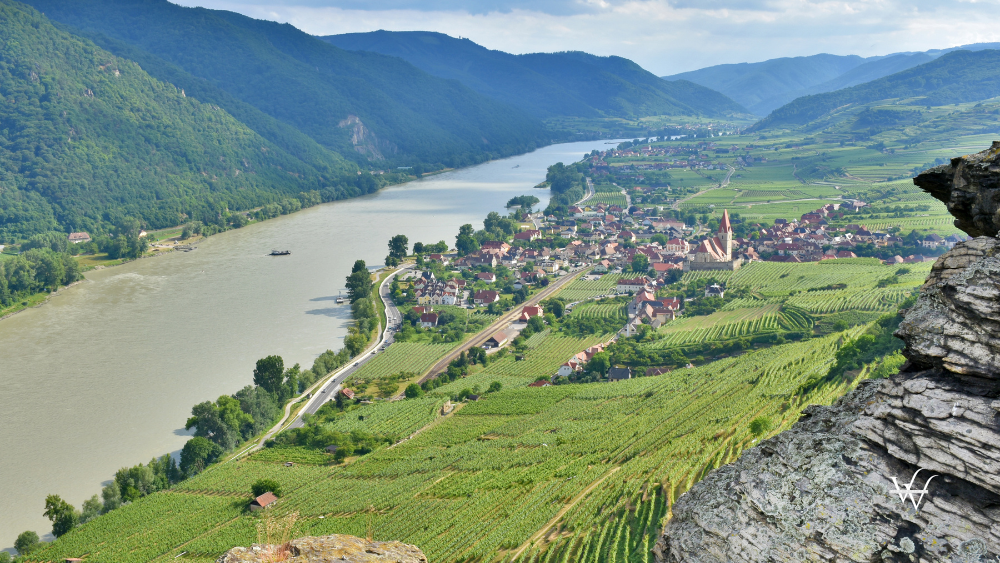Wachau, one of Austria’s most celebrated wine regions, boasts a history and geography as complex and intriguing as the wines it produces.
This storied landscape, nestled along the Danube River, has been shaped by millions of years of geological and climatic evolution, culminating in a unique terroir that nurtures some of the world’s finest wines.
The Geological Foundations
Over millions of years, the mighty Danube River has carved its way through the solid gneiss, amphibolite, marble, and quartzite that define the Wachau's rugged terrain. The steep slopes of the Danube valley are formed from ancient, hard crystalline rocks, such as different forms of gneiss, amphibolite, marble, and quartzite. Finely pleated Gföhl gneiss is prevalent, as well as paragneiss, and consolidated granodiorite gneiss around Spitz. Dark amphibolite, which forms basic layers that alternate frequently with paragneiss, can be traced back to lava from underwater volcanoes. Marble with characteristic grey and white stratification can be found in the western parts of Wachau.
An old slide mass can be found between Wösendorf and Weißenkirchen, on the lower flanks of the valley. It is composed of weathered, chaotically bedded rocks and boulders, and the former sliding surfaces are smeared with kaolin and red loam. Small remains of gravels, sands, silts, and clays, such as those on the Spitzer Burgberg and around Weißenkirchen, are testimony of this area having developed from the Molasse zone, which was crossed by rivers and flooded by seas between 30 and 15 million years ago.
Loess and River Gravel
Loess, often as a veneer or blanket on top of the older rock, is also present in the Wachau. Coarse river gravel covered with a layer of fine sediment from floods forms the floor of the Danube valley today.
A Medieval Legacy of Stone Terraces
The viticultural landscape of Wachau is marked by its medieval stone terrace walls. These terraces were meticulously constructed under the governance of Bavarian monasteries, who recognized the potential of the sun-drenched hillsides for wine production. These ancient walls not only prevent soil erosion but also retain heat, creating a microclimate that benefits the vines.
Dynamic Climate Interactions
Wachau’s climate is a dynamic interplay of two powerful climate zones: the western Atlantic and the eastern Pannonian. This unique climatic confluence is further influenced by microclimates created by the region’s varied topography. The hot, dry summers and cold winters are moderated by the Danube’s expansive waters. Cool winds from the Waldviertel region to the north cause significant temperature fluctuations between day and night, especially in the crucial months leading up to the harvest. This diurnal temperature variation enhances the aromatic complexity of the grapes, contributing to the distinctive character of Wachau wines.
Wachau DAC: A Testament to Regional Typicity
In recognition of its unique terroir, Wachau was granted the protected designation of origin (DAC) status. Since the 2020 vintage, Wachau DAC wines have been classified into three categories, reflecting the diversity and typicity of the region:
- Gebietswein (Regional Wine): Grüner Veltliner, Riesling, Weissburgunder, Grauburgunder, Chardonnay, Neuburger, Muskateller, Sauvignon Blanc, Traminer, Frühroter Veltliner, Müller-Thurgau, Muskat Ottonel, Roter Veltliner, Gemischter Satz, Pinot Noir, Sankt Laurent, Zweigelt or cuvées made from them.
- Ortswein (“Villages” Wine): Grüner Veltliner, Riesling, Weissburgunder, Grauburgunder, Chardonnay, Neuburger, Muskateller, Sauvignon Blanc, or Traminer.
- Riedenwein: Grüner Veltliner, Riesling.
A key characteristic of all Wachau DAC wines is that the grapes must be harvested by hand, ensuring meticulous selection and quality.
Vinea Wachau’s Classification System
Since the mid-1980s, the Vinea Wachau winegrowers' association has classified dry white wines (and occasionally rosés) into three categories based on their natural alcohol content:
- Steinfeder: Light, fragrant wines with up to 11.5% alcohol by volume (abv), named after the feathery grass Stipa pennata.
- Federspiel: Classic wines with 11.5–12.5% abv, a term borrowed from falconry.
- Smaragd: Powerful Reserve wines with a minimum of 12.5% abv, named after the emerald-colored lizards that bask in the Wachau vineyards.
A Culinary and Oenological Journey
Beyond the vineyards, the Wachau region offers a rich culinary landscape. Historic wine-growing villages such as Spitz, Weißenkirchen, Joching, Dürnstein, and Loiben are home to leading winegrowers and top-notch restaurants. Exploring these villages and crossing the Danube to the right bank reveals a tapestry of local flavors and traditional hospitality, making Wachau not just a destination for wine enthusiasts but for anyone seeking a taste of Austria’s rich cultural heritage.

